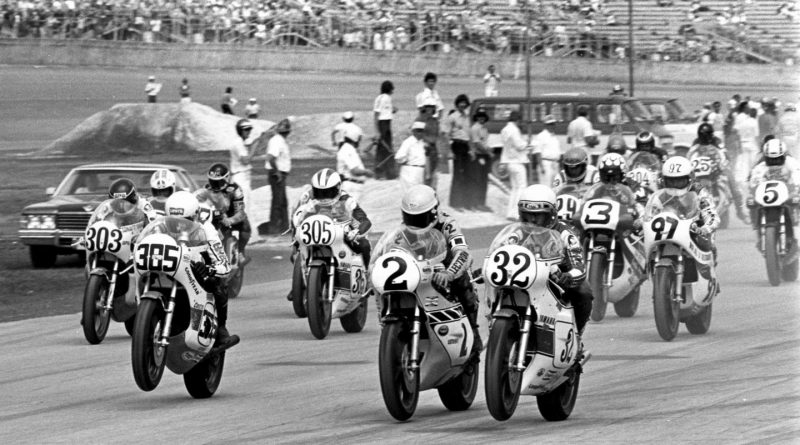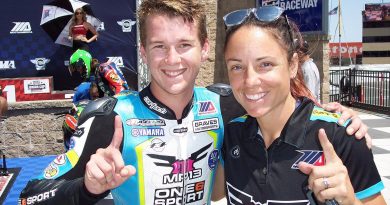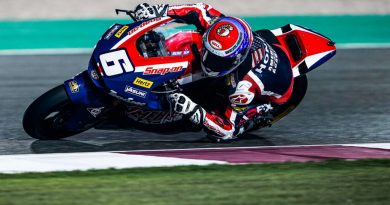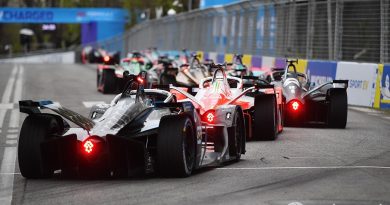Throwback Thursday: The 1977 Daytona 200
The start of the 1977 Daytona 200, with Steve Baker (32) and Kenny Roberts (2) already locked in battle. Photo by Tom Riles.
The reason it’s called the Daytona 200 is quite simply because that’s how many miles the riders travel from the start of the race to the finish. But, in 1977, Daytona “200” was a misnomer. Before the race was even run, it would have been more accurate to call it the “Daytona Double 100” or the “Daytona 2 x 100.”
In 1977, the Daytona 200 was the first round of the newly formed F750 or Formula 750 World Championship and, a few days prior to the race, an international jury of the Fédération Internationale de Motocyclisme (FIM) had decided to divide the first world championship event of the year into two, 100-mile heats. The purpose of the unusual format was to incorporate a mandatory tire change. For several years prior, tire problems had plagued the teams competing in the 200, but no one had gone to a quick-change rear wheel setup for pit stops.
For the 1977 Daytona 200, Goodyear had developed a much more robust rear slick, but it had only been tested on the previous season’s bikes. The company couldn’t guarantee that its new tire would last 200 miles on the latest Yamahas, which for the first time were full-on, 750cc, four-cylinder, two-stroke GP machines instead of the 700cc motorcycles of years past.
In the practice sessions leading up to the 1977 Daytona 200, the fastest motorcycles, by far, were the factory Yamahas YZR750s ridden by Americans Kenny Roberts and Steve Baker, as well as Venezuelan and defending Daytona 200 Champion Johnny Cecotto. In addition to having more horsepower than the other bikes, the factory YZR750s had brand-new bodywork. The tail sections of the bikes were much more aerodynamic, designed to close the hole in the air behind the bikes and affect drafting, which is such an important part of the Daytona 200.
In qualifying, Baker set a new outright lap record of 111.772 mph on the 3.87-mile course that combined almost three-quarters of the banked oval with a series of five flat turns in the infield. Roberts, who had been the polesitter for the past two Daytona 200s, missed eclipsing Baker’s lap time by just .115 of a second.
Roberts had been considered the top U.S. road racer, but Baker was certainly raising eyebrows. The two riders’ bikes were virtually identical except that the livery on Roberts’ factory Yamaha was the signature bright-yellow and black “bumblebee” design that became iconic for Yamaha U.S. and especially for Roberts when he went to Europe the following year and proceeded to win three 500cc World Championships in a row. Baker’s YZR750 was resplendent in the white-and-red livery that was used on all of Yamaha’s world championship machines at the time (and that is being featured as an extra-cost option on Yamaha’s 2022 Supersport models in celebration of the company’s 60 years of competition in the Grand Prix World Championship).
The race began under overcast skies, and Baker and Roberts led the snarling field of 79 bikes across the starting line. During the first 17 laps, the pair traded the lead four times, but then Baker started to stretch his lead. Roberts eventually slowed his pace and dropped back, but he was still able to remain comfortably in second.
The gap between the two eventually grew to 28 seconds, and Baker handily won the first leg of the two-heat race. There was supposed to have been a one-hour beak before the start of the second leg, but heavy rain began falling shortly after Baker won the first leg which caused the second leg to be canceled. Baker was declared the official winner, and he pocketed $19,000 of the $102,800 total purse for the event.
And, that’s not all that Baker won. Based on his Daytona 200 performance, Yamaha immediately signed him to contest the rest of the 1977 F750 World Championship, which he went on win, becoming America’s first-ever motorcycle road racing World Champion.
FOOTNOTE: Not only did Steve Baker win the 1977 Daytona 200 and the 1977 F750 World Championship, but he also finished second to Barry Sheene in the 1977 500cc World Championship. That year, he competed in 21 F750 and 500cc GP events, scoring 16 podium finishes. Along the way, he raced nine weekends in a row, including Anderstorp, Sweden; Imatra, Finland; Brno, Czechoslovakia; Silverstone in England; Zolder in Belgium; Assen in the Netherlands; Laguna Seca in the U.S., and Mosport in Canada. 1977 was quite a rookie season for American Steve Baker.
To purchase tickets for all MotoAmerica events, click HERE
For information on how to watch the MotoAmerica Series, click HERE
For the full 2022 MotoAmerica Series schedule, click HERE




